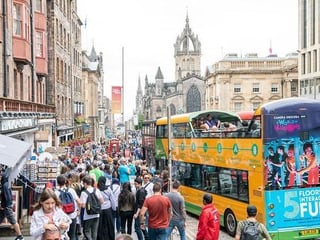How to ensure Edinburgh remains a world-leading festival city – Julia Amour


Does Edinburgh still love its festivals? The facts show the answer is resoundingly yes, though you might not get that impression from recent debate. We need to come together to tackle the city’s issues that are causing such concern – so we can develop a festival city for the future, with more of our children and grandchildren able to enjoy our culture and see a window on the world as our citizens have done for many generations.
Later this month, thousands of schoolchildren will get up close and personal with science professionals in an annual event called Careers Hive, organised by the team behind the Edinburgh Science Festival, who also take live science experiments on countrywide roadshows all year round. This is as much a part of the lasting legacy of Edinburgh’s Festivals as tangible city landmarks like the Traverse theatre and the Filmhouse.
Advertisement
Hide AdAdvertisement
Hide AdThe most important legacy, however, is invisible – it’s the energy of classic and contemporary culture that has lit up our city and provided countless moments of inspiration and shared understanding for over 70 years.
Thanks to their eclectic programmes, the city’s 11 major festivals together attract more than two-thirds of Edinburgh residents to attend: enhancing lives, providing livelihoods and helping put Edinburgh among the top-rated places to live in the world.
Not just for culture vultures
City surveys show that only half of those people go to theatre, live music, museums or art galleries outside of festival times – so although there’s more to do to make the festivals accessible to all, they already reach well beyond the usual culture vultures.
In order to safeguard these benefits, it’s obviously critical to recognise and deal with real concerns about living standards and sustainability in our fast-growing historic city.
Advertisement
Hide AdAdvertisement
Hide AdThis matters greatly to the future of its residents and its festivals. Polarised views won’t help find workable solutions, so it’s more important than ever to work collaboratively to address the challenges.
We should recognise that the past decade of austerity has taken a toll, but the city has done well to weather the downturn compared to many others at home and abroad.
The festivals’ ability to connect people and ideas at local, national and international levels is an asset that will stand Edinburgh and Scotland in good stead as we enter uncertain times after Brexit.
However, they also need constant reinvention, especially if we are to continue to inspire the next generation and ensure the festivals have something of benefit to offer to everyone.
Advertisement
Hide AdAdvertisement
Hide AdFor the festivals, growth for growth’s sake is not our agenda. Rather, our focus is to ensure that Edinburgh is a place of great cultural discoveries and experiences from home and abroad.
But the figures show that Edinburgh is a popular and growing city, and that brings an increased need to manage impacts.
More people-friendly streets
Recent city statistics show that resident numbers have increased by more than 13 per cent in a decade, well outpacing Scotland-wide growth of 4.5 per cent.
At the same time, affordable travel and favourable exchange rates have fuelled a steady increase in year-round tourism which leads to a concentration of people in the city centre especially during the peak summer holiday period.
Advertisement
Hide AdAdvertisement
Hide AdSo we must find ways to manage flows of people and traffic better. We are strongly supportive of measures to make streets and public spaces much more people-friendly for pedestrians, through managing the city centre while reducing pollution and congestion to keep traffic moving.
Festivals are working with city planners, transport providers and researchers to help map flows of people around the city during our peak times, so that better data can help future city management.
As with other attractive global cities, the tourism and population growth has been accompanied by a rapid increase in unregulated short-term lets all year round.
Such developments have led to a shift in city centre housing patterns and concerns about those communities being able to thrive. So it’s an important step forward that the city will soon have new legal powers to manage short-term lets to ensure that Edinburgh’s unique character is secured.
An incredible legacy
Advertisement
Hide AdAdvertisement
Hide AdOn these and other complex challenges shared by cultural capitals worldwide, now is the time to map out how Edinburgh can protect and enhance our city and its festivals for the future.
The issues we face can’t be approached in isolation, which is why partnership-working with organisations and residents across the city is so important and why we will use the festivals’ networks to get people talking together.
It’s clear that the festivals have already created an incredible legacy that we want to build on for the future, while of course there are legitimate concerns around our city’s growth that need to be tackled.
Only through joint action can we support the kind of developments – from smart travel to sustainable procurement to new community infrastructure – that will enable Edinburgh to remain a world-leading festival city with people and culture at the heart of its success.
Julia Amour, director of Festivals Edinburgh, the membership organisation for the city’s 11 major festivals
